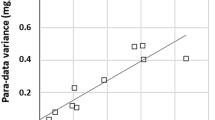Abstract
Nonlinear mixed effect model is the most used technique when developing a pharmacokinetic population model (PopPK), the characterization of a drug disposition into the body and taking decisions related to the dose adjustments. The covariate model is used to establish a relationship between the model parameters and the characteristics of the patients, and it helps to explain sources of variability in the PopPK. A known problem in the development of a covariate model is to decide which covariates should or should not be included in the model. In this work, a genetic algorithm (GA) was used to decide which covariates contribute in a major degree prediction of the variability in a PopPK model.
Access this chapter
Tax calculation will be finalised at checkout
Purchases are for personal use only
Similar content being viewed by others
References
Bonate, P.L.: Pharmacokinetic-Pharmacodynamics Modeling and Simulation. Springer, Berlin (2011)
Rosenbaum, S.: Basic pharmacokinetics and pharmacodynamics. Wiley, Hoboken (2011)
Katarina, V., Branislava, M., Sandra, V., Zoran, T., Milica, P., Iztok, G.: Population Pharmacokinetic Analysis of Therapeutic Drug Monitoring Data in Optimizing Pharmacotherapy of Antiepileptic Drugs. In: Foyaca-Sibat, H. (ed.) Novel Treatment of Epilepsy, pp. 96–106. In Tech, Croatia (2011)
Khandelwal, A., Harling, K., Jonsson, E.N., Hooker, A.C., Karlsson, M.O.A.: A fast method for testing covariates in population PK/PD models. AAPS J. 13(3), 464–472 (2011)
Davidian, M., Giltinan, D.M.: Nonlinear models for repeated measurement data: an overview and update. J. Agric. Biol. Environ. Stat. 8(4), 387–419 (2003)
Ulrika, W., Jonson, E.N., Karlsson, M.O.: Comparison of stepwise model building strategies in population pharmacokinetic-pharmacodynamic analysis, Oct 2002
Gabrielsson, J., Weiner, D.: Pharmacokinetic & Pharmacodynamic Data Analysis: Concepts and Applications. Apotekarsocieteten, Stockholm (2006)
Kim, S., Li, L.: A novel global search algorithm for nonlinear mixed-effects models. Springer, Berlin (2011)
Mould, D.R., Upton, R.N.: Basic concepts in population modeling, simulation, and model-based drug development (2012)
Bozdogan, H.: Model Selection and AKAIKE’S information criterion (AIC): the general theory and its analytical extensions. Psychometrika 52(3), 345–370 (1987)
Holland, J.H.: Adaptation in Natural and Artificial Systems. University of Michigan Press, Ann Arbor (1975)
Sivanandam, S.N., Deepa, S.N.: Introduction to Genetic Algorithms. Springer, Berlin (2008)
WookAhn, C.: Advances in Evolutionary Algorithms. Theory, Design and Practice. Springer, Berlin (2006)
Eiben, A.E., Smith, J.E.: Introduction to Evolutionary Computing. Springer, Berlin (2003)
Lowen, R., Verschoren, A.: Foundations of Generic Optimization. Springer, Berlin (2008)
Acknowledgments
We thank to Instituto Politécnico Nacional (IPN), to the Comisión de Fomento y Apoyo Académico del IPN (COFAA), and the Mexican National Council of Science and Technology (CONACYT) for supporting our research activities.
Author information
Authors and Affiliations
Corresponding author
Editor information
Editors and Affiliations
Rights and permissions
Copyright information
© 2015 Springer International Publishing Switzerland
About this chapter
Cite this chapter
Montiel, O., Cornejo, J.M., Sepúlveda, C., Sepúlveda, R. (2015). Obtaining Pharmacokinetic Population Models Using a Genetic Algorithm Approach. In: Melin, P., Castillo, O., Kacprzyk, J. (eds) Design of Intelligent Systems Based on Fuzzy Logic, Neural Networks and Nature-Inspired Optimization. Studies in Computational Intelligence, vol 601. Springer, Cham. https://doi.org/10.1007/978-3-319-17747-2_24
Download citation
DOI: https://doi.org/10.1007/978-3-319-17747-2_24
Published:
Publisher Name: Springer, Cham
Print ISBN: 978-3-319-17746-5
Online ISBN: 978-3-319-17747-2
eBook Packages: EngineeringEngineering (R0)




